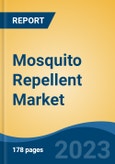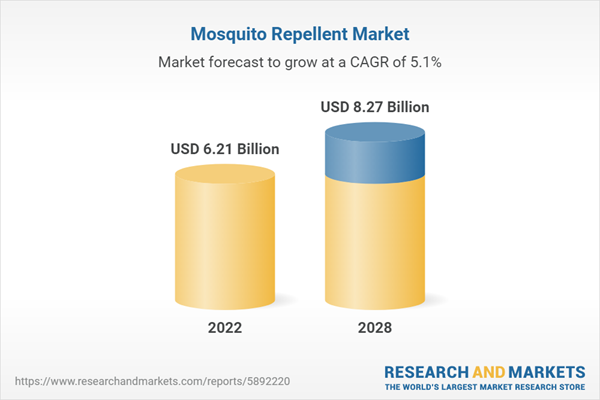Speak directly to the analyst to clarify any post sales queries you may have.
10% Free customizationThis report comes with 10% free customization, enabling you to add data that meets your specific business needs.
Key Market Drivers
Escalating Threat of Mosquito-Borne Diseases
The escalating prevalence of diseases transmitted by mosquitoes, including malaria, dengue fever, Zika virus, and West Nile virus, has catalyzed the demand for effective mosquito repellents. As individuals seek protection against these potentially life-threatening ailments, the market experiences heightened demand for repellent products.Heightened Health Awareness
Enhanced awareness about the health risks associated with mosquito bites has spurred consumer demand for preventive measures. Individuals are now more informed about the imperative of employing mosquito repellents to mitigate their exposure to vector-borne diseases.Urbanization's Ongoing Expansion
Urbanization has fostered the creation of environments conducive to mosquito breeding. The concentration of populations in urban areas elevates the risk of disease transmission, motivating individuals to seek protection through mosquito repellent products.Travel and Tourism's Impact
With the increasing accessibility of international travel, individuals encounter diverse mosquito species and prevalent diseases in different regions. This has engendered the necessity for effective repellents, particularly for travelers venturing into regions with heightened mosquito activity.Environmental Considerations
Growing environmental consciousness has spurred demand for eco-friendly and natural mosquito repellents. Consumers are pursuing alternatives that effectively repel mosquitoes while minimizing harm to the environment and non-target species.Effective Marketing and Advertising
Robust marketing campaigns and advertising endeavors by manufacturers have elevated awareness about the availability and advantages of diverse mosquito repellent products. These campaigns educate consumers about protection's significance and the array of available options.Government-Led Initiatives
In regions where mosquito-borne diseases pose significant public health concerns, governments and health organizations frequently advocate the use of mosquito repellents as part of comprehensive disease prevention strategies. This has augmented product adoption.Product Diversity
The market has witnessed a proliferation of mosquito repellent products, spanning sprays, lotions, creams, patches, electronic devices, and even clothing treated with repellent. This diversity caters to varied consumer preferences and lifestyles.Key Market Challenges
Environmental Considerations
Numerous traditional mosquito repellents incorporate chemicals like DEET and picaridin, which may adversely impact the environment. These chemicals can infiltrate water bodies, exerting repercussions on aquatic ecosystems. The growing demand for environmentally friendly and biodegradable repellents aims to address these concerns.Health and Safety Apprehensions
While mosquito repellents are indispensable in preventing mosquito-borne diseases, certain chemical-based formulations could harbor potential health risks, particularly with excessive usage or among sensitive individuals. Ensuring repellents' safety and efficacy assumes paramount importance.Resistance Development
Mosquitoes can develop resistance to specific active ingredients utilized in repellents over time. This poses challenges in crafting formulations that are effective and long-lasting, necessitating continuous research and the development of novel repellent technologies.Regulatory Adherence
The mosquito repellent market is subject to diverse regulations and guidelines, which vary by region and nation. Manufacturers must navigate intricate regulatory terrains to ensure that their products are compliant and safe for utilization.Availability and Accessibility
In certain regions, accessibility to mosquito repellents is hampered by factors such as affordability, distribution impediments, and inadequate healthcare infrastructure. Ensuring widespread availability and affordability holds immense significance, especially in regions with heightened mosquito-borne disease prevalence.Consumer Preferences
As consumer awareness of health and environmental concerns burgeons, demand for natural and plant-based repellents has surged. Manufacturers must cater to multifarious consumer preferences while upholding product efficacy.Innovative Formulations
The market's reliance on conventional repellent formulations like lotions and sprays can potentially stifle innovation. Developing novel and convenient application methods, such as wearable devices or enduring patches, presents technical challenges.Key Market Trends
Health Awareness and Disease Mitigation
Mounting awareness regarding mosquito-borne diseases such as malaria, dengue fever, Zika virus, and West Nile virus has propelled consumers to seek effective mosquito repellent solutions. Governments, health organizations, and media campaigns have been instrumental in educating the public about the gravity of protection.Technological Progression
The market has borne witness to remarkable technological innovations in mosquito repellent products. From traditional sprays and creams to sophisticated devices leveraging ultrasonic waves, LED lights, and electrostatic mechanisms, manufacturers consistently explore novel avenues to repel mosquitoes while prioritizing user safety and convenience.Natural and Organic Solutions
Consumer predilections have veered toward natural and organic products, reflecting concerns about potential health risks linked to certain chemical constituents. This trend has sparked an uptick in demand for mosquito repellents formulated with natural oils such as citronella, eucalyptus, and lavender.Wearable and Inventive Formats
Wearable mosquito repellent solutions, encompassing wristbands and clothing infused with repellent properties, have gained traction. These formats bestow users with sustained protection sans the necessity for frequent reapplication.Efficacy and Prolonged Performance
Consumers increasingly seek mosquito repellents that confer prolonged protection and efficient functionality, especially in locales characterized by elevated mosquito activity.Environmental Considerations
Anxiety regarding the repercussions of chemical mosquito repellents on the environment has spurred the development of eco-friendly and biodegradable alternatives. Manufacturers explore sustainable packaging and ingredients to resonate with environmentally conscious consumers.Urbanization and Travel's Confluence
Swift urbanization and amplified global travel have contributed to mosquito expansion into new realms. This phenomenon propels demand for portable and travel-friendly mosquito repellent products.Digital Marketing and E-Commerce
Manufacturers harness digital marketing strategies and e-commerce platforms to widen their reach. Online platforms empower consumers to access an array of mosquito repellent products and facilitate seamless comparisons of features and feedback.Segmental Insights
Type Insights
Coils assume a prominent position within the global mosquito repellent market during the forecast period. Mosquito coils represent a favored method of mosquito repellence, deterring mosquitoes and other flying insects. Known for their efficacy in repelling mosquitoes, these coils emit smoke or vapor laden with insecticides, effectively warding off mosquitoes from the vicinity. Mosquito coils often prove more cost-effective relative to other forms of mosquito repellents such as electronic devices or sprays. This cost-efficiency renders them accessible to a wide spectrum of consumers, particularly in regions grappling with mosquito-borne diseases. A single mosquito coil can confer protection for several hours, rendering them a convenient choice for extended periods of mosquito exposure, such as outdoor activities or nighttime sojourns. Employing mosquito coils is straightforward-users simply ignite the coil, enabling it to generate mosquito-repelling smoke. Diverse formulations of mosquito coils are available, encompassing regular coils, gradual-release coils, and variants featuring assorted scents. This assortment empowers consumers to select coils aligning with their predilections. Mosquito coils are commonly employed outdoors, rendering them suitable for camping, picnics, barbecues, and other al fresco gatherings. In certain regions, the utilization of mosquito coils constitutes a cultural custom and a facet of daily existence, thus contributing to their widespread adoption. Novel coil formulations focus on minimizing environmental impact through reduced utilization of harmful chemicals.Sales Channel Insights
The ascent of the online distribution channel has wielded substantial influence over the global mosquito repellent market. Online shopping endows consumers with the convenience of perusing and procuring mosquito repellent products from the comfort of their homes or mobile devices. This accessibility has extended the market's reach to a global scale. Online platforms present an assorted array of mosquito repellent products spanning diverse brands, formulations, and types. Consumers can explore a gamut of options and opt for products resonating with their proclivities and needs. Online retailers furnish detailed product descriptions, ingredient enumerations, customer reviews, and ratings. This wealth of information empowers consumers to make judicious determinations regarding their mosquito repellent selections. Consumers can seamlessly compare prices, features, and efficacy of distinct mosquito repellent products across various online platforms. This functionality facilitates the identification of optimal products tailored to specific requirements. Online retailers frequently extend exclusive deals, discounts, and bundled offerings for mosquito repellent products. Such promotions allure budget-conscious consumers and exert influence over their purchasing choices. Online distribution obviates geographical constraints, permitting consumers to procure mosquito repellent products from a spectrum of brands and regions, which might be unavailable through local brick-and-mortar stores. A multitude of mosquito repellent manufacturers and brands have embraced direct-to-consumer (DTC) strategies, directly vending their products to consumers via dedicated websites. This approach establishes a direct nexus between brands and their customers.Regional Insights
The Asia Pacific region occupies a momentous role within the global mosquito repellent market throughout the forecast period. Many Asia Pacific nations exhibit tropical or subtropical climates conducive to mosquito proliferation. This propensity engenders an elevated prevalence of mosquito-borne diseases and heightens the demand for effective mosquito repellents. Diseases transmitted by mosquitoes, such as malaria, dengue fever, chikungunya, and Zika virus, represent substantial health concerns across several Asia Pacific countries. This drives the requisition for mosquito repellents as a prophylactic measure against these diseases. The Asia Pacific region encompasses a substantial proportion of the global population. The high population density prevalent in numerous areas expands the consumer base for mosquito repellent products. In several countries within the region, employing mosquito repellents is deeply ingrained within daily routines due to the prevalence of mosquitoes and mosquito-borne diseases. This cultural acceptance fosters consistent demand for repellent products. The climate in myriad Asia Pacific countries fosters outdoor activities, intensifying the demand for effective mosquito repellents to forestall mosquito bites during open-air events and gatherings. Accelerated urbanization in the Asia Pacific region may result in overcrowded living conditions, thereby creating an environment conducive to mosquito breeding. This urbanization accentuates the requirement for dependable mosquito repellents. The region attracts a substantial influx of tourists, positioning it as a coveted travel destination for individuals across the globe. Numerous tourists seek effective mosquito repellents to shield themselves from locally prevalent mosquito-borne diseases.Key Market Players
- Spectrum Brands Holdings, Inc.
- Reckitt Benckiser Group plc
- 3M Company
- Godrej Consumer Products Limited
- Tender Corporation
- Avon Company
- Dainihon Jochugiku Co., Ltd.
- Nice Group Co., Ltd.
- The Coleman Company, Inc.
- Enesis Group
Report Scope:
In this report, the global mosquito repellent market has been segmented into the following categories, in addition to the industry trends which have also been detailed below:Global Mosquito Repellent Market, By Type:
- Smart
- Conventional
Global Mosquito Repellent Market, By Sales Channel:
- Supermarkets/Hypermarkets
- Departmental Stores
- Convenience Stores
- Online
- Others
Global Mosquito Repellent Market, By Region:
- North America
- Europe
- South America
- Middle East & Africa
- Asia Pacific
Competitive Landscape
Company Profiles: Detailed analysis of the major companies present in the global mosquito repellent market.Available Customizations:
Global Mosquito Repellent Market report with the given market data, the publisher offers customizations according to a company's specific needs.This product will be delivered within 1-3 business days.
Table of Contents
Companies Mentioned
- Spectrum Brands Holdings, Inc.
- Reckitt Benckiser Group plc
- 3M Company
- Godrej Consumer Products Limited
- Tender Corporation
- Avon Company
- Dainihon Jochugiku Co., Ltd.
- Nice Group Co., Ltd.
- The Coleman Company, Inc.
- Enesis Group
Table Information
| Report Attribute | Details |
|---|---|
| No. of Pages | 178 |
| Published | October 2023 |
| Forecast Period | 2022 - 2028 |
| Estimated Market Value ( USD | $ 6.21 Billion |
| Forecasted Market Value ( USD | $ 8.27 Billion |
| Compound Annual Growth Rate | 5.1% |
| Regions Covered | Global |
| No. of Companies Mentioned | 10 |









